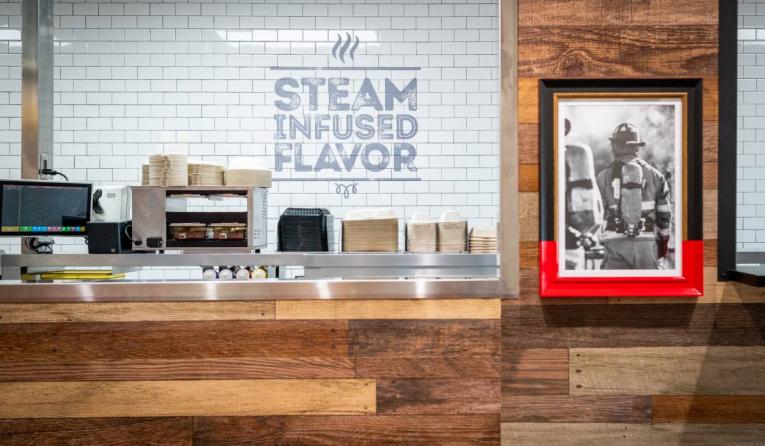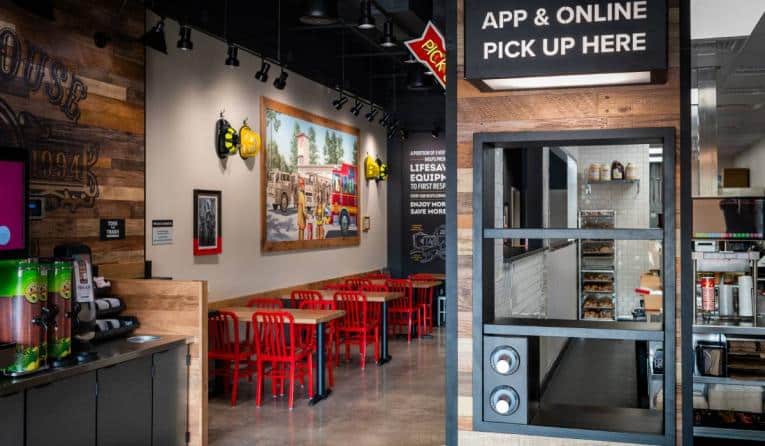If Mike Hancock was going to take an opportunity outside of Tim Hortons, it was going to have to be a rare one. The 6-foot-7 former defensive end, who played in the Canadian Football League with the Toronto Argonauts, had a first-row seat to the near-mythical nature of the coffee chain. There’s one for every 10,000 Canadians, and some 80 percent of residents reportedly visit Tim Hortons every month. That frequency is even higher than McDonald’s in the U.S., where CEO Chris Kempczinski previously suggested roughly 80 percent of the population shows up at least once each year.
Hancock had spent three calendars as COO at Tim Hortons before parent company Restaurant Brands International—where he’d worked for nine years—acquired Firehouse Subs in December 2021 for $1 billion. The sandwich chain hadn’t expanded its C-suite in 11 years before Hancock shifted over to the same COO role. That specific position had sat vacant since 2009 when Don Fox was promoted to CEO (Vince Burchianti was the last executive appointment as CFO in 2011).
“If I was going to take on another challenge, I wanted to go somewhere that had a lot of parallels in terms of the brand love, the community support, product quality, and Firehouse checked all those boxes,” Hancock says. “I think of Firehouse almost as very, very similar [to Tim Hortons] in many ways, just almost at an earlier stage.”
This is a sentiment Fox shares as well. He told QSR Tim Hortons was a “fascinating brand” for him to learn about when the deal was initially struck. Fox clocked 23 years at RBI sister chain Burger King and knew a good deal about the company’s other pillar, Popeyes. “But I didn’t know much about Tim’s,” he said then. “They are so unique, in the greatest of ways. To have that kind of penetration in [Canada]; that kind of love. They are all things coffee.”
“I’ll tell you,” he added, “if I want to consider somebody a big brother that I want to grow up to be, in many respects, it’s that brand.”
Fox stepped down as CEO in March after 12 years in the post, moving to chairman. In tandem, Hancock elevated to president of Firehouse.
Hancock immediately turned to those equities. “We’re No. 1 in supporting our communities. Our [Public Safety Foundation] is really unparalleled in the industry. Our product quality, we lead in hot sandwiches. People love our sandwiches. We do a phenomenal job from the guest satisfaction. Those fundamentals don’t come every day in our industry.”
Naturally, one of the allures of acquiring Firehouse for RBI was its whitespace. The brand closed 2022 with 1,187 locations, up 23 year-over-year. Average-unit volumes were $924,000 and U.S. systemwide sales $1.154 billion. Both were higher than 2021, when AUV and systemwide sales clocked in at $909,000 and $1.044 billion, respectively.
Firehouse’s runway is both an in-house comparison as well as a category one. Starting with the latter, five sandwich chains today are significantly larger in the U.S. than Firehouse, which tripled in unit count from 2010 to 2021.
- Subway: 20,576
- Arby’s: 3,415
- Jimmy John’s: 2,637
- Jersey Mike’s: 2,397
- Panera: 2,102
Among its closest peers, by AUV:
- Jersey Mike’s: $1.210 million
- Firehouse: $924,000
- Jimmy John’s: $900,000
- Subway: $510,000
RBI as a company has long leaned into net-unit expansion since forming in the wake of a 2014, $11 billion takeover of Tim Hortons.
The story at Firehouse in particular, though, is, as Hancock mentioned, an early innings development. Before getting into U.S. potential, Firehouse in June opened its first location outside of North America. The Zurich, Switzerland, store preceded a development agreement in Mexico. Together, David Shear, RBI’s president of international, said, they represent “the first steps in our international expansion,” as Firehouse looks to grow across EMEA, APAC, and Latin America. The Zurich location will be used as a showcase for future international development as well. It features a reimagined guest-centric approach that includes self-order kiosks, mobile ordering, a dedicated area for click and collect, table service, and 62 seats inside. It was a natural entry given RBI’s international HQ in Zurich.
Hancock says Firehouse did “a bunch of research” in markets across Europe and Latin America, and Switzerland was one that popped. But broadly, it’s a clear and visible path. “Our largest competitor has an enormous international presence,” Hancock says. “Clearly, there is desire for our product across the world, and we believe we have the best product in the entire industry.”
In recent months, Subway inked agreements in Bahrain, Georgia, Mainland China, Uruguay, Costa Rica, and Panama to add more than 4,000 restaurants across Europe, Middle East and Africa (EMEA), Asia Pacific (APAC), and Latin America, and the Caribbean within the next two decades.



Alongside Firehouse’s overseas push, it plans to take on Canada (RBI’s main HQ). The chain has 63 Canadian units presently, with 100 percent of those in Ontario. Hancock says Firehouse has ample room to keep spreading out from that base, as well as target Western Canada and Atlantic Canada (there are nearly 3,000 Subways in the country). “It’s a great market for us in general,” he adds, noting the momentum from Tims in Canada carries over. “We have excellent franchisees there. Really, really strong operations and the folks working with us to help us grow further throughout the country are some of our top operators.”
The challenge and intrigue for Firehouse outside of the U.S. comes down to this infant stage of growth. Burger King, for instance, is generally going to have a store within 500 miles of wherever RBI wants to drop it.
Headed into its purchase of Firehouse, RBI totaled 27,667 units, with close to 17,000 existing outside the U.S. It touted more than 500 outposts in China (1,620), Brazil (928), Spain (897), Russia (792), Germany (744), and the U.K. (538); and over 400 in Mexico (450), Australia (443), South Korea (425), and France (416). Firehouse has zero restaurants in any of those places.
Additionally, excluding Spain, where there are only 51, a sandwich chain not named Firehouse boasted at least 384 stores in every one. In Australia (1,221), the U.K. (2,211) and Brazil (1,641), there are significant strongholds.
“For us, we’re almost having to recreate the brand in certain markets,” Hancock says. “That’s the challenging part. The thing that I think really gives us a ton of opportunity and why we’re really set up for success, is that our products translate really well everywhere we’ve tested them. We did probably one of the largest testings, or research, we’ve done with any new brand across many, many countries with our products. And everywhere we went it scored extremely well with our existing menu.”
Firehouse will likely tweak its menu as it scales, but generally, the core holds up. “I’ve got to give a lot of credit to the team that’s been here for a long time. The founders, Robin and Chris [Sorensen], and what they’ve been able to build. I don’t think you see that with all brands,” Hancock says.
The aforementioned foundation has helped give back north of $80 million to first responders and public safety organizations in the U.S. and Canada. “I think we’ve been pleasantly surprised to see how universally first responders are respected and revered across so many countries throughout the entire world,” Hancock adds. “So for us, we really have two major links there: it’s a product that translates really well everywhere we go, and a big piece of our brand is how we give back to our communities and our mission, and that translates really well across the entire world.”
Shifting to the U.S., half of Firehouse’s current system (over 400 franchisees in total) are single-store operators. It’s a reality that inspired Hancock and RBI to invest roughly $20 million into new development with existing franchisees. The chain just launched the biggest incentive program it’s done as a brand, Hancock says, which is designed to spur growth from within. The 2023 Development Incentive Program is available to operators who agree to develop and open at least two new Firehouse restaurants in 2024 and 2025 (unless approved otherwise). It’s only available to existing franchisees.
Operators are being asked to sign the area development agreement by March 21, 2024. If franchisees agree to add a store, the DIP contribution is $50,000 per restaurant. That lifts to $75,000 if they sign on to build two, and $100,000 if it’s three-plus. “This incentive program is actually going to be done in the form of credits. When folks commit to building restaurants as they get close to actually opening up their restaurants, they’re able to receive these credits, Hancock says. “It’s very unique in the way it’s structured. It’s an enormous investment from us and it’s because we think there’s so much growth and so much upside ahead of us within North America.”
Again, Hancock sees similarities to Tim Hortons and its fleet of smaller, local franchisees. “It’s part of your life and it means so much more when it’s not some big corporation operating restaurants. These are local operators who are in there every single day,” he says.
Hancock’s focus these days, in addition to growth, is profitability focused. The more money franchisees make and feel good about the ROI, the likelier they’d get on this rocket ship, he says.
Coming under RBI’s purview has helped Firehouse negotiate and bring down some commodities as well as thread technology throughout the chain. It recently launched a new app with a fresh interface a more personalized features. “That’s the first step I’d say of many steps of how we’re going to hope to bring more value to our franchisee system,” Hancock says.
Furthermore, Firehouse opened a new concept restaurant in July in Jacksonville, Florida, that features a newly designed kitchen layout, with an updated steamer and toaster equipment. Both aim at boosting service times and ensuring consistency. Franchisees will have the opportunity to retrofit existing kitchens to the package.
The concept doesn’t adjust the look and feel of Firehouse from the outside—it’s still the “community design”—and doesn’t materially change square footage. The Loretto Road opening is a bit smaller, but the kitchen upgrade works in any Firehouse build, Hancock says. “Something that we’ve received plenty of feedback from our guests on is how Firehouse is not always the quickest concept,” he says. “So what improvements can we make to ensure that we’re a bit quicker for our guests who don’t have 20 or 30 minutes for a lunch experience? We’re really excited about this new opening. We’re hoping to get a lot of learnings from it and hopefully in the not-so-distant future, we can apply those learnings to other restaurants.”








